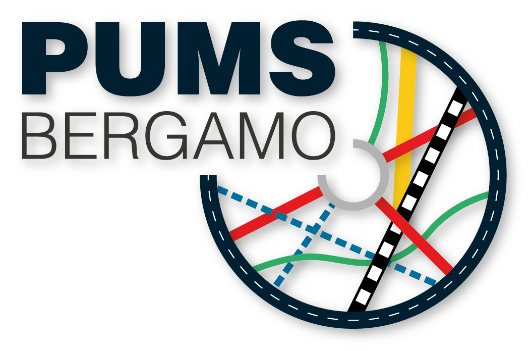- Topic
- Urban mobility planning
- Country
- Italy
- Resource type
- Case study
First published on 8 December 2020.
Context
With 120,000 residents, Bergamo is the fourth largest city in the Lombardy region in northern Italy and is the second most visited city in the area after Milan. Centred in an almost 400,000-inhabitant (and growing) functional urban area, it has a strategic location in Lombardy and is served by the third-busiest airport in Italy with 13.9 million passengers in 2019. According to the origin-destination survey carried out by ‘Regione Lombardia’ in 2014, 366,000 daily journeys are undertaken in the region.
Mobility in Bergamo is a special challenge as the city is divided into two centres:
- Città Alta (‘Upper City’), a hilltop medieval town, surrounded by 16th century defensive walls (a UNESCO World Heritage Site since 9 July 2017).
- Città Bassa (‘Lower City"), with the modern centre of Bergamo.
The two parts of the city are connected by a funicular railway, roads and footpaths. Overall, 53% of urban trips are made by car and 14% using public transport. The share of walking and cycling mobility is greater than 31%.
In 2018, ATB Mobilità S.p.A. (the public-owned company running, among others, the city’s bus network) entrusted TRT Trasporti e Territorio S.r.l. with drafting the Sustainable Urban Mobility Plan (SUMP) for the Municipality of Bergamo, which would replace the old Urban Mobility Plan that dated back to 2008. Drafting the SUMP for Bergamo was undertaken in a way that was consistent with the methodology suggested by the European Commission and with the guidelines issued by the Italian Ministry of Transport (Decree 4 August 2017 and following amendments).
Bergamo’s SUMP was accepted by the City Council in May 2019 and final approval is underway.
In action
Within the SUMP, there was a decision to outline an evolutionary scenario for the city of Bergamo and its functional urban area, because there was a need to recognise a vision of policies for the mobility sector for the next 10 years. The strategic vision of policies needs to guarantee good accessibility levels in the territory while ensuring environmental, economic and social sustainability. The guiding criterion of the SUMP is based on the concept of sustainability, to be achieved through implementing measures, specific tools and actions that should be consistent with a common and shared vision for the city.
To do this, the planning process was organised in four phases:
- Conducting a background analysis of the demographic structure and the mobility-related framework, together with its environmental, social and economic impacts. This analysis was done using different open-data sources, additional data collected and provided by the municipality, and surveys carried out by ATB. In addition, there were several opportunities to obtain information from local and regional administrations, city users and stakeholders.
- Evaluating the current situation (known as the Status Analysis) (using a diagnostic framework; and a strengths, weaknesses, opportunities and threats (SWOT) analysis), and the subsequent definition of the general and specific sets of objectives.
- Developing the SUMP document, including identifying different scenarios (Reference Scenario and Planning Scenario), selecting related policies and measures, and conducting the ex-ante evaluation of the different scenarios.
- The acceptance process. This involves collecting final observations from people and organisations (and any objections they may have) and carrying out the approval process, which is still underway and is expected to be finished in the coming months.
Two aspects of the planning process deserve highlighting as they illustrate the accuracy and the tailor-made decisions that characterise the ambitious, yet feasible, vision of the city of Bergamo – the ex-ante evaluation process and the participatory approach.
The planning process was accompanied by an ex-ante evaluation process, which estimated the impacts generated by the interventions included in the different scenarios. In this way, it was possible to make the necessary adjustments to the SUMP to obtain the desired results. Two evaluation tools were used to improve accuracy and involve as many variables as possible.
The first tool was the Sustainable MObility MOdel (MOMOS), an evaluation tool developed by TRT, which was used for the strategic evaluation. The tool offered support in analysing different policies for sustainable mobility in Bergamo’s functional area. It enables an integrated overview to be produced that compares alternative hypotheses of intervention and considers a wide variety of sustainable policies.
The second tool was AIMSUN®, a traffic micro-simulation model. This is a sophisticated and detailed tool that was used to evaluate the vehicle mobility component and the effects on the road network deriving from the infrastructure and road regulation interventions envisaged in the SUMP scenarios. The tools complemented each other and helped to increase the accuracy of assessing the impacts of the final decisions that were taken.
The second aspect that deserves highlighting, and which is a fundamental element of the SUMP process, is the participatory process. The involvement of different stakeholders (city users, associations, and public and private representatives) took place in several phases:
- Firstly, an online survey hosted on the city’s website took place from September to November 2018. The survey aimed to identify the needs and priorities of the local community with respect to the mobility system. Approximately 1,200 people responded.
- The next phase involved listening to the local community. This was achieved through an institutional meeting dedicated to stakeholders and city users to debate the current status of urban mobility, and to discover the mobility attitudes and perceptions of the participants.
- Finally, between January and February 2019, additional opportunities for listening and debate were activated by organising four thematic focus groups.
- use of public space and environment;
- Upper City and the historic centre;
- public transport and shared services;
- urban logistics.
The main stakeholders in the region (such as entrepreneurs, associations and representatives of the local community) were invited to the meetings. Their purpose was to collect useful requests, ideas and visions from other stakeholders for developing the SUMP scenarios.
The participatory approach adopted by the planners and decision makers was an essential element in identifying challenges, and selecting the planning strategies and packages of measures. The strategies of Bergamo’s SUMP were defined by considering a complex set of elements which, starting from the outcomes of the cognitive framework and the definition of strengths and weaknesses, promote the vision of mobility in the city for the next decade.
In addition, it is important to highlight that the sustainability of the SUMP has been supported by both a Strategic Environmental Assessment (SEA) and an assessment on the effects of the plan on the ‘Boschi dell’Astino e dell’Allegrezza’ Nature Reserve which is a Site of Community Importance (SCI).
Results
Among the main objectives of the SUMP is integrating mobility choices with territorial and environmental ones – focusing heavily on modal shift and improving the quality of the city's public spaces. Some of the main objectives are:
- reducing car dependency in favour of the more sustainable modes of transport (walking, cycling and public transport);
- making city streets and public space compatible with the needs of different road users (pedestrians, cyclists and public transport users);
- promoting economic efficiency and optimising resource use;
- improving liveability, accessibility and attractiveness for all users by preserving the city’s peculiarities and the sustainability of the mobility system;
- protecting the historical parts of the city from the intrusion of car and logistics traffic;
- reducing air pollution and energy consumption.
These objectives will be achieved by implementing a wide-ranging set of policies and measures that are coherent with one another, and are able to operate in synergy, thus giving coherence to the definition of sustainable mobility in the city and helping to make it tangible.
Bergamo already had an outline for implementing a set of measures and policies for the next 10 years that were planned independently from the SUMP. Because of this, the SUMP evaluated two different scenarios – a Reference Scenario and a Planning Scenario. The first one, also known as the business-as-usual scenario, describes the development forecast if the current policy trend is continued and only measures that have already been planned are implemented. It constitutes the starting and comparison point for the design of the Planning Scenario (the second one).
The comparison between the Reference Scenario and the Planning Scenario allows to recognise the ability to meet the general and specific objectives selected within the SUMP. In other words, with the support of modelling tools mentioned above, this method enables an ex-ante evaluation of the effectiveness of the set of proposed measures to be formulated.
According to the simulations carried out by comparing the Planning Scenario with the Reference Scenario, implementing the mobility policies included in Bergamo’s SUMP would, by 2030, lead to a 6% reduction in car trips, a 21% increase in passengers on the public transport network and a 23% reduction in the number of kilometres travelled by conventional (polluting) vehicles. In addition, it would lead to an increase in cycle use (especially for short-distance trips). The environment would also benefit from the application of the SUMP measures with a generalized reduction in emissions (a drop of 15% in CO2, 20% in PM10, 27% in CO, 25% in NOx, 14% in VOC and 13% in the total fuel consumption of transport).
A detailed cost estimate was also provided. The SUMP foresees investments of approximately EUR 375 million, which will be spread over the 10 years of its life. A significant portion of these, about EUR 280 million, is destined for the public transport infrastructure that is included in the Plan – a new tramway line (T2) and a railway connection to Orio al Serio airport.
Challenges, opportunities and transferability
The approach applied and developed in Bergamo and its functional urban area is certainly of potential interest to other cities. Indeed, the challenges and the critical issues faced by Bergamo are comparable to those affecting other medium-sized cities in Italy.
It is worth mentioning that the SUMP process also foresees continuous monitoring of the status of the implementation of the planned measures, based on a selection of indicators which illustrates the status and trends of the mobility and transport system. The procedure is based on verifying compliance with the intermediate results every 2 years, which are defined as steps towards reaching the final objectives. The monitoring is also an opportunity to determine the effectiveness of the SUMP or to recognise the need for changes and improvements. In addition, adopting similar approaches in other cities would facilitate further comparison between different cities and contexts, and the exchange of good practice.
‘This SUMP deals with the issue of accessing the city from the vast area in contrast with the previous mobility plans that have looked mostly to the problems of the city centre. Instead, the SUMP is intended for solving the critical issues of Campagnola, Malpensata, Colognola, Boccaleone, Celadina, Grumello, Valtesse, Monterosso and of all those districts that are currently affected by traffic flows entering in Bergamo. The mobility choices of the coming years will put the whole city at the centre: in this way, the centre expands to the local neighbourhoods, and the local neighbourhoods become little centres themselves. If we release the pressure from cars, the whole city will benefit’, explained the Councillor for mobility Stefano Zenoni.
In Depth
The full text of the Sustainable Urban Mobility Plan (in Italian).
For more specific, relevant information about Bergamo’s SUMP, please contact: Ivan uccelli, TRT Trasporti e Territorio, uccelli@trt.it
This case study has been prepared for the European Commission however it reflects the views only of the authors, and the European Commission is not liable for any consequence stemming from the reuse of this publication.



